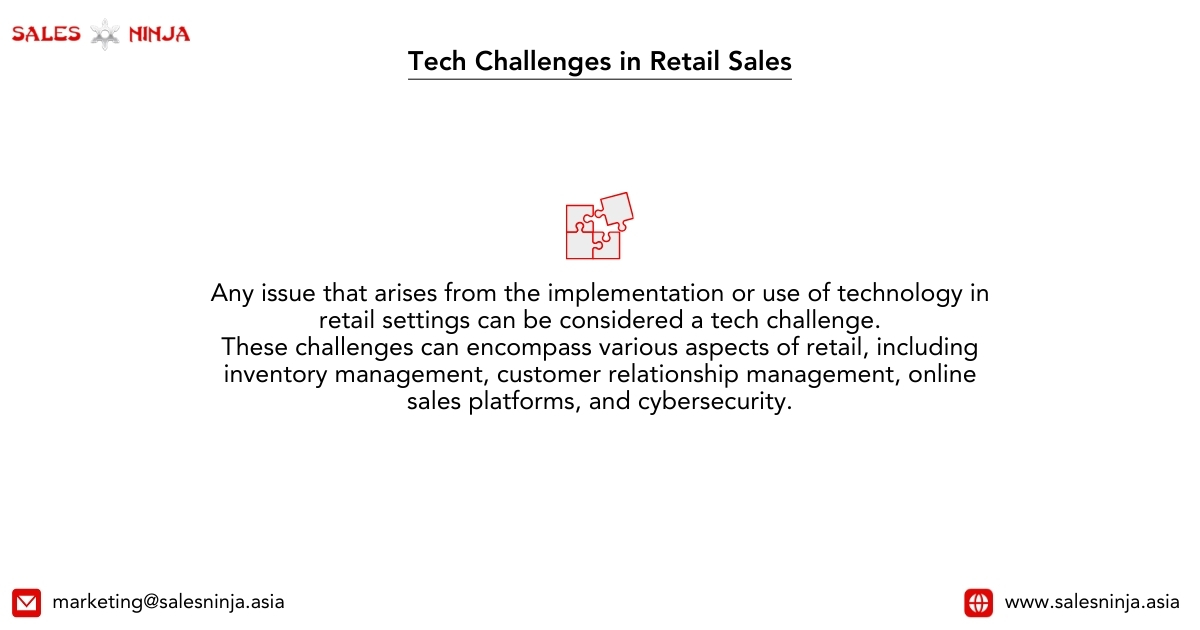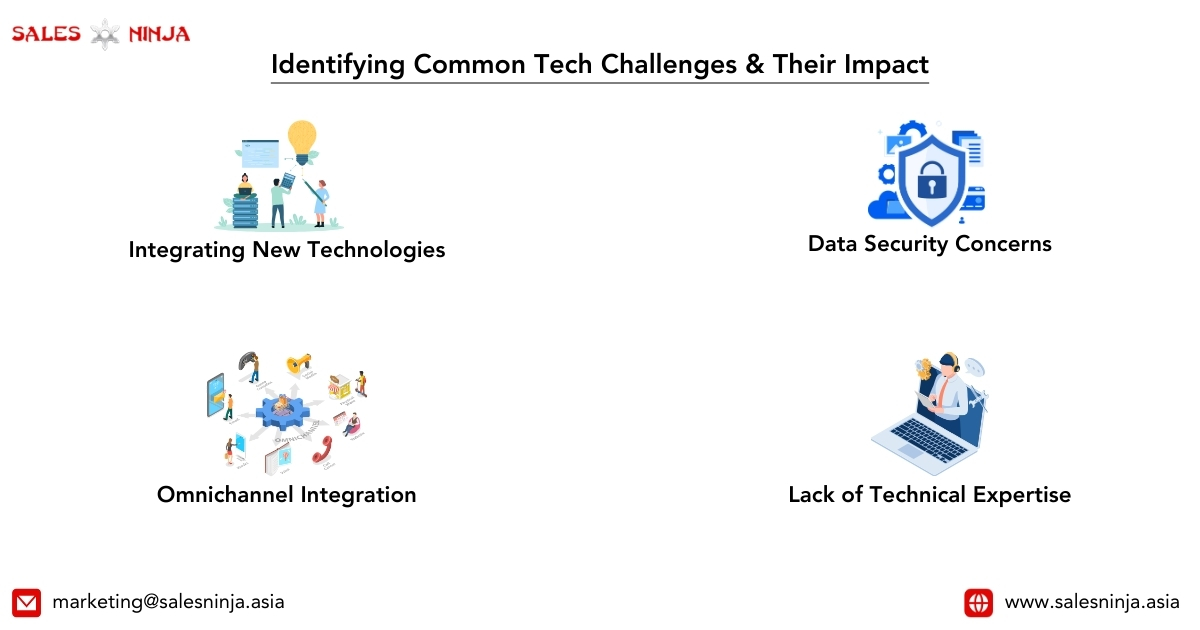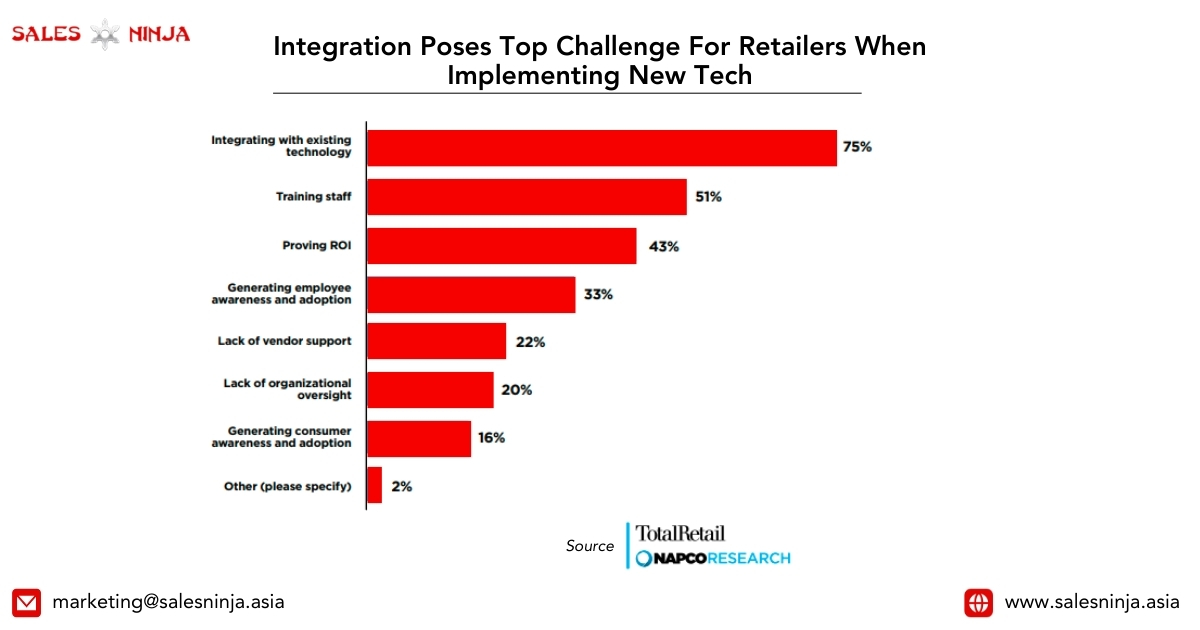The rapid evolution of consumer behaviour, driven by digital transformation, has revolutionized the way retailers operate. From the seamless integration of online and offline channels to the demand for personalized shopping experiences. Technology has become indispensable for retailers looking to thrive in the modern marketplace.
However, with great opportunity comes great challenges. These difficulties, which can hinder growth and sales performance, range from cybersecurity issues to problems with inventory management.
Yet, amid the complexities of navigating tech challenges, there’s still hope. Even if learning about all this new technology seems hard, it’s not impossible. With the right plans and solutions, you can beat these problems and come out even stronger.
Understanding Tech Challenges in Retail Sales

Understanding Tech Challenges in Retail Sales
So, what exactly are these “tech challenges” we keep talking about? In the context of retail sales, they’re the difficulties and obstacles you encounter when trying to leverage technology effectively to improve your business. These challenges can encompass various aspects of retail, including inventory management, customer relationship management, online sales platforms, and cybersecurity. Essentially, any issue that arises from the implementation or use of technology in retail settings can be considered a tech challenge.
For instance, a retail store may struggle with inventory management software that is outdated or incompatible with other systems. This could lead to inaccuracies in stock levels, resulting in overstocked shelves or missed sales opportunities due to stockouts.
Impact of Tech Challenges on Retail Operations and Sales Processes:
The impact of tech challenges on retail operations and sales processes can be significant. These challenges can disrupt workflows, hinder productivity, and ultimately affect the customer experience. For example, if a retailer’s website experiences frequent crashes or slow loading times due to outdated infrastructure, it can lead to frustrated customers and lost sales.
Another example could be cybersecurity breaches, where sensitive customer data is compromised. This not only damages the retailer’s reputation but also erodes customer trust, leading to decreased sales and loyalty.
Identifying Common Tech Challenges and Their Impact

Identifying Common Tech Challenges and Their Impact
Technology has become the invisible hand shaping customer journeys and influencing sales success. But with this power comes a new set of hurdles you need to be aware of.
Here’s a breakdown of the most common tech challenges plaguing retailers today, along with the impact they can have on your bottom line:
Integrating New Technologies:
Integrating new technologies into retail operations poses a significant challenge for retailers. When adopting new systems, retailers often face difficulties ensuring compatibility with existing infrastructure and processes. For example, a retail store may invest in a new point-of-sale (POS) system only to find that it does not integrate seamlessly with its inventory management software. Additionally, training staff on new tools and technologies can be time-consuming and disruptive to daily operations.
If new technologies are not integrated seamlessly or if staff members are not adequately trained, it can lead to errors, delays, and inconsistencies in customer interactions. This can ultimately result in reduced sales performance and customer satisfaction.
Data Security Concerns:
Retailers often face significant challenges related to data security when handling customer information and payment data. Retailers are constantly at risk of cyberattacks aimed at stealing customer data or disrupting business operations. These threats can range from malware and phishing attacks to sophisticated hacking attempts. Additionally, some retailers may lack the necessary infrastructure and resources to implement comprehensive security measures, leaving them vulnerable to cyber threats.
The problem is here that a data breach or security incident can severely damage a retailer’s reputation and erode customer trust. Even customers are less likely to do business with a retailer that cannot guarantee the security of their personal information.
In addition to reputational damage, retailers may incur significant financial losses as a result of data breaches. This can include costs associated with investigating the breach, notifying affected customers, and implementing security improvements.
Suppose a small boutique retailer that processes customer payments using an outdated POS system. Due to inadequate security measures, the retailer’s system is compromised by a cyberattack, resulting in the theft of customer credit card information. As news of the breach spreads, customers lose confidence in the retailer’s ability to protect their data, leading to a decline in sales and revenue.
Omnichannel Integration:
Many retailers operate on separate systems for their brick-and-mortar stores and online platforms, making it difficult to synchronize data and provide a unified experience. For example, maintaining consistent pricing and promotional strategies across online and offline channels. Besides, sometimes managing inventory across multiple channels becomes complex, leading to issues such as overselling or stockouts if inventory levels are not accurately synchronized.
But without seamless integration, customers may encounter inconsistencies in product availability, pricing, or promotions across different channels. Leading to frustration and potential loss of sales. Retailers may miss out on opportunities to upsell or cross-sell to customers if they cannot effectively track customer interactions and preferences across channels.
For example, consider a retail chain that operates both physical stores and an e-commerce website. Despite efforts to integrate their systems, the retailer struggles to synchronize inventory levels between their online and offline channels. As a result, customers may encounter discrepancies in product availability when shopping online versus in-store, leading to frustration and a negative shopping experience.
Lack of technical expertise:
A significant challenge faced by retailers is the lack of technical expertise within their organization, hindering their ability to effectively leverage technology for business improvement. This encompasses various aspects, including implementing and managing technology solutions, analyzing data, and staying abreast of technological advancements.
A lack of technical expertise may result in retailers missing out on opportunities to implement innovative solutions or capitalize on emerging trends putting them at a competitive disadvantage. Additionally, inadequate technical knowledge can leave retailers vulnerable to data breaches and cybersecurity threats, potentially damaging their reputation and eroding customer trust.
What Survey Says?
The ‘2023 Retail Technology Report’ by Total Retail, reveals that integrating new technology with existing systems is the most common challenge for retailers, with 75 percent of respondents citing it as a major obstacle. This marks a significant increase from 61 percent in the previous year’s survey.
Another prominent challenge identified in the report is training staff on new technology solutions. The labour market’s volatility, coupled with difficulties in filling IT roles, exacerbates this challenge for retailers.

Top Challenges For Retailers
However, retailers voiced various concerns when asked about their biggest challenges in implementing new technology into their businesses. Some of them are:
-Integrating new tech with older systems due to rapid changes and cost concerns.
-Limited vendor support during COVID-19, relying on online chat and email.
-Budget constraints for staff training.
-Outdated technology and associated implementation costs.
-Concerns over software integration and plug-and-play functionality.
These responses highlight the multifaceted nature of tech challenges faced by retailers, from integration issues to budget constraints and vendor support limitations.
Overcoming Tech Challenges
We’ve broken down the common technological challenges you. As a retailer, might face – integrating new systems, securing data, creating a seamless omnichannel experience, and navigating limited technical expertise. Now we’re here to provide you with the tools and techniques you need to overcome these obstacles and realize the full potential of technology in your business.
Integration Smooth Sailing: Investing in user-friendly solutions with robust support and training programs can help minimize disruptions to operations and ensure a smooth transition for staff. And, here’s how to avoid this iceberg:
- Plan and research: Before diving in, thoroughly research different systems and their compatibility with your existing infrastructure.
- Seek expert help: Consult with IT professionals who can guide you through the selection and integration process.
- Consider phased integration: Instead of a complete overhaul, consider integrating new systems in phases, allowing for smoother implementation and staff training.
Building Your Data Fort Knox: Data security is no joke. Here’s how to fortify your defences:
- Invest in robust security measures: Implement firewalls, anti-virus software, and data encryption to protect your systems and customer information.
- Regularly update your software: Stay ahead of security threats by applying updates for your operating systems and applications promptly.
- Educate your staff: Train your employees on cybersecurity best practices, such as recognizing phishing attempts and using strong passwords.
Unifying Your Online and Offline Worlds: Customers expect a seamless experience no matter how they shop. Here’s how to bridge the gap:
- Invest in omnichannel solutions: Utilize platforms that allow you to manage inventory, pricing, and customer data across all channels in a unified manner.
- Break down data silos: Ensure information flows freely between your online and offline systems, providing a consistent experience for customers.
- Offer click-and-collect options: Allow customers to purchase online and pick up in-store, enhancing convenience and encouraging cross-channel shopping.
Upskilling Your Tech Crew: Don’t let a lack of technical expertise hold you back. Here’s how to bridge the knowledge gap:
- Invest in employee training: Provide your staff with training programs on new technologies and systems they’ll be using.
- Partner with tech experts: Consider partnering with IT consultants or managed service providers who can offer ongoing support and expertise.
- Embrace a learning culture: Encourage a culture of continuous learning within your organization, allowing employees to stay updated on the latest technological advancements.
Remember that solving technological problems requires ongoing effort. It’s a continual process that calls for preparation, funding, and a dedication to improvement. Through the use of these tactics and adjustment to the always-changing technological environment. You may utilize the potential of technology and steer your retail enterprise towards prosperity.
Stay Informed and Empowered to Drive Your Business Forward in the Digital Era
Addressing tech challenges in retail sales is imperative for staying competitive in today’s digital age. So we encourage all of you (retailers) to adopt proactive strategies and embrace innovation to navigate the complexities of the modern retail environment successfully.
Follow our website to explore further resources and tools offered by our company to help you overcome tech challenges and optimize your retail operations. And reach out for consultation or assistance with your specific tech challenges. Subscribe to our newsletter or follow our social media channels for more insights, tips, and updates on navigating tech challenges in retail sales.






Leave A Comment